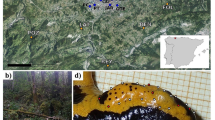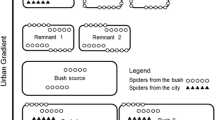Abstract
Urbanization poses serious extinction risks, yet some species thrive in urban environments. This may be due to a pronounced developmental plasticity in these taxa, since phenotypically, plastic organisms may better adjust to unpredictable urban food resources. We studied phenotypic plasticity in Nuctenea umbratica, a common European forest and urban vegetation spider. We subjected spiderlings to low (LF), medium (MF) and high (HF) food treatments and documented their growth and developmental trajectories into adulthood. Spiders from the three treatments had comparable numbers of instars and growth ratios, but differed in developmental periods. Longest developing LF spiders (♀ = 390, ♂ = 320 days) had the smallest adults, but MF (♀ = 300, ♂ = 240 days) and HF (♀ = 240, ♂ = 210 days) spiders reached comparable adult sizes through shorter development. While males and females had comparable instar numbers, females had longer development, higher growth ratios, adult sizes and mass; and while males adjusted their moulting to food availability, female moulting depended on specific mass, not food treatment. We discussed the patterns of Nuctenea sex-specific development and compared our results with published data on two other Holarctic urban colonizers (Larinioides sclopetarius, Zygiella x-notata) exhibiting high plasticity and fast generation turn-over. We conclude that despite relatively unconstrained developmental time in the laboratory enabling Nuctenea to achieve maximal mass and size—main female fitness proxies—their relatively fixed growth ratio and long generation turn-over may explain their lower success in urban environments.


Similar content being viewed by others
References
Ahmad T (2012) On the food preferences and application of Dyar’s rule to different hopper instars of Acrida exaltata Walker (Orthoptera: Acrididae). Zool Ecol 22:114–124
Andersson MB (1994) Sexual selection. Princeton University Press
Atkinson D, Sibly RM (1997) Why are organisms usually bigger in colder environments? Making sense of a life history puzzle. Trends Ecol Evol 12:235–239
Blackledge TA, Kuntner M, Agnarsson I (2011) The form and function of spider orb webs: evolution from silk to ecosystems. In: Casas J (ed) Advances in Insect Physiology, vol 41. Academic Press, Burlington, pp 175–262
Blanckenhorn WU (2005) Behavioral causes and consequences of sexual size dimorphism. Ethology 111:977–1016
Blanckenhorn WU, Dixon AF, Fairbairn DJ, Foellmer MW, Gibert P, van der Linde K, Wiklund C (2007) Proximate causes of Rensch’s rule: does sexual size dimorphism in arthropods result from sex differences in development time? Am Nat 169:245–257
Bonduriansky R (2007) The evolution of condition-dependent sexual dimorphism. Am Nat 169:9–19
Bucher R, Herrmann JD, Schüepp C, Herzog F, Entling MH (2010) Arthropod Colonisation of trees in fragmented landscapes depends on species traits. Open Ecol J 3:111–117
Buczkowski G (2010) Extreme life history plasticity and the evolution of invasive characteristics in a native ant. Biol Invasions 12:3343–3349
Christenson TE, Goist KC (1979) Costs and benefits of male–male competition in the orb weaving spider, Nephila clavipes. Behav Ecol Sociobiol 5:87–92
Cole BJ (1980) Growth ratios in holometabolous and hemimetabolous insects. Ann Entomol Soc Am 73:489–491
Couret J, Dotson E, Benedict MQ (2014) Temperature, larval diet, and density effects on development rate and survival of Aedes aegypti (Diptera: Culicidae). PLoS One 9:e87468
Davidowitz G, Nijhout HF (2004) The physiological basis of reaction norms: the interaction among growth rate, the duration of growth and body size. Integr Comp Biol 44:443–449
Dmitriew CM (2011) The evolution of growth trajectories: what limits growth rate? Biol Rev 86:97–116
Dyar HG (1890) The number of molts of Lepidopterous Larvae. Psyche 5:420–422
Enders F (1976) Size, food-finding, and Dyar's constant. Environ Entomol 5:1–10
Esperk T, Tammaru T, Nylin S (2007) Intraspecific variability in number of larval instars in insects. J Econ Entomol 100:627–645
Fernández-Montraveta C, Moya-Laraño J (2007) Sex-specific plasticity of growth and maturation size in a spider: implications for sexual size dimorphism. J Evol Biol 20:1689–1699
Flenner I, Richter O, Suhling F (2010) Rising temperature and development in dragonfly populations at different latitudes. Freshwater Biol 55:397–410
Foelix R (2010) Biology of spiders. Oxford University Press
Foellmer MW, Fairbairn DJ (2005) Competing dwarf males: sexual selection in an orb-weaving spider. J Evol Biol 18:629–641
Gilles J, Lees R, Soliban S, Benedict M (2010) Density-dependent effects in experimental larval populations of Anopheles arabiensis (Diptera: Culicidae) Can Be Negative, Neutral, or Overcompensatory Depending on Density and Diet Levels. J Med Entomol 49:1001–1011
Gimnig JE, Ombok M, Otieno S, Kaufman MG, Vulule JM et al (2002) Density-dependent development of Anopheles gambiae (Diptera: Culicidae) Larvae in Artificial Habitats. J Med Entomol 39:162–172
Gotthard K (2000) Increased risk of predation as a cost of high growth rate: an experimental test in a butterfly. J Anim Ecol 69:896–902
Head G (1995) Selection on fecundity and variation in the degree of sexual size dimorphism among spider species (Class Araneae). Evolution 49:776–781
Heiling AM, Herberstein ME (1998) The web of Nuctenea sclopetaria (Araneae, Araneidae): relationship between body size and web design. J Arachnol 26:91–96
Heiling AM, Herberstein ME (1999) The importance of being larger: intraspecific competition for prime web sites in orb-web spiders (Araneae, Araneidae). Behaviour 136:669–677
Herberstein ME, Elgar MA (1994) Foraging strategies of Eriophora transmarina and Nephila plumipes (Araneae: Araneoidea): Nocturnal and diurnal orb-weaving spiders. Aust J Ecol 19:451–457
Higgins LE (1992) Developing plasticity and fecundity in the orb-weaving spider Nephila clavipes. J Arachnol 20:94–106
Higgins LE (1993) Constraints and plasticity in the development of juvenile Nephila clavipes in Mexico. J Arachnol 21(107–11):9
Higgins LE, Rankin MA (1996) Different pathways in arthropod postembryonic development. Evolution 50:573–582
Higgins LE, Coddington JA, Goodnight C, Kuntner M (2011) Testing ecological and developmental hypotheses of mean and variation in adult size in nephilid orb-weaving spiders. Evol Ecol 25:1289–1306
Kearney MR, Briscoe NJ, Karoly DJ, Porter WP, Norgate M, Sunnucks P (2010) Early emergence in a butterfly causally linked to anthropogenic warming. Biol Lett 6:674–677
Kingsolver JG (2007) Variation in growth and instar number in field and laboratory Manduca sexta. Proc R Soc Lond Biol 274:977–981
Kingsolver JG, Huey RB (2008) Size, temperature, and fitness: three rules. Evol Ecol Res 10:251–268
Kleinteich A, Schneider JM (2011) Developmental strategies in an invasive spider: constraints and plasticity. Ecol Entomol 36:82–93
Kralj-Fišer S, Schneider JM (2012) Individual behavioural consistency and plasticity in an urban spider. Anim Behav 84:197–204
Kralj-Fišer S, Gregorič M, Lokovšek T, Čelik T, Kuntner M (2013) A glimpse into the sexual biology of the “zygiellid” spider genus Leviellus. J Arachnol 41:387–391
Kuntner M, Zhang S, Gregorič M, Li D (2012) Nephila female gigantism attained through post-maturity molting. J Arachnol 40:344–346
Leborgne R, Pasquet A (1987) Influences of aggregative behaviour on space occupation in the spider Zygiella x-notata (Clerck). Behav Ecol Sociobiol 20:203–208
Li D, Jackson RR (1996) How temperature affects development and reproduction in spiders: a review. J Therm Biol 21:245–274
Li D, Jackson RR (1997) Influence of diet on survivorship and growth in Portia fimbriata, an araneophagic jumping spider (Araneae: Salticidae). Can J Zool 75:1652–1658
Liu Z, Xu B, Sun J (2014) Instar numbers, development, flight period, and fecundity of Dendroctonus valens (Coleoptera: Curculionidae: Scolytinae) in China. Ann Entomol Soc Am 107:152–157
Mayntz D, Toft S, Vollrath F (2003) Effects of prey quality and availability on the life history of a trap-building predator. Oikos 101:631–638
McKinney ML (2002) Urbanization, biodiversity, and conservation the impacts of urbanization on native species are poorly studied, but educating a highly urbanized human population about these impacts can greatly improve species conservation in all ecosystems. Bioscience 52:883–890
McKinney ML (2008) Effects of urbanization on species richness: a review of plants and animals. Urban Ecosyst 11:161–176
Miyashita K (1968) Growth and development of Lycosa T-insignita Boes. et Str. (Araneae: Lycosidae) under different feeding conditions. Appl Entomol Zool 3:81–88
Nentwig W, Blick T, Gloor D, Hänggi A, Kropf C (2014) Araneae, spiders of Europe (v. 3). Available online at: http://www.araneae.unibe.ch/
Nijhout HF (1975) A threshold size for metamorphosis in the tobacco hornworm, Manduca sexta (L.). Biol Bull 149:214–225
Nijhout HF (1979) Stretch-induced moulting in Oncopeltus fasciatus. J Insect Physiol 25:277–281
Nijhout HF, Willams CM (1974) Control of moulting and metamorphosis in the tobacco hornworm, Manduca sexta (L.): cessation of juvenile hormone secretion as a trigger for pupation. J Exp Biol 61:493–501
Przibram H, Megušar F (1912) Wachstumsmessungen an Sphodromantis bioculata Burm. Dev Genes Evol 34:680–741
Robinson S, Partridge L (2001) Temperature and clinal variation in larval growth efficiency in Drosophila melanogaster. J Evol Biol 14:14–21
Roff DA (2002) Life history evolution. Sinauer, Sunderland
Safranek L, Williams CM (1984) Critical weights for metamorphosis in the tobacco hornworm, Manduca sexta. Biol Bull 167:555–567
Shochat E, Warren PS, Faeth SH, McIntyre NE, Hope D (2006) From patterns to emerging processes in mechanistic urban ecology. Trends Ecol Evol 21:186–191
Sol D (2003) Behavioural flexibility: a neglected issue in the ecological and evolutionary literature? In: Reader SM, Laland KN (eds) Animal innovation. Oxford University Press, Oxford, pp 63–82
Sol D, Lapiedra O, González-Lagos C (2013) Behavioural adjustments for a life in the city. Anim Behav 85:1101–1112
Spiller DA (1992) Numerical response to prey abundance by Zygiella x-notata (Araneae, Araneidae). J Arachnol 179–188
Stearns SC (1992) The evolution of life histories. Oxford University Press, London
Stillwell RC, Davidowitz G (2010) Sex differences in phenotypic plasticity of a mechanism that controls body size: implications for sexual size dimorphism. Proc R Soc Lond Biol 277:3819–3826
Stillwell RC, Blanckenhorn WU, Teder T, Davidowitz G, Fox CW (2010) Sex differences in phenotypic plasticity affect variation in sexual size dimorphism in insects: from physiology to evolution. Ann Rev Entomol 55:227–245
Suter RB (1990) Determinants of fecundity in Frontinella pyramitela (Araneae, Linyphiidae). J Arachnol 18:263–269
Van Buskirk J, Steiner UK (2009) The fitness costs of developmental canalization and plasticity. J Evol Biol 22:852–860
Vollrath F (1980) Male body size and fitness in the web-building spider Nephila clavipes. Z Tierpsychol 53:61–78
West-Eberhard MJ (2003) Developmental plasticity and evolution. Oxford University Press
Yeh PJ, Price TD (2004) Adaptive phenotypic plasticity and the successful colonization of a novel environment. Am Nat 164:531–542
Acknowledgments
This work was funded by the Slovenian Research Agency (grants Z1―4194 and P1―0236).
Author information
Authors and Affiliations
Corresponding author
Additional information
Communicated by: Sven Thatje
Rights and permissions
About this article
Cite this article
Kralj-Fišer, S., Čelik, T., Lokovšek, T. et al. Development and growth in synanthropic species: plasticity and constraints. Naturwissenschaften 101, 565–575 (2014). https://doi.org/10.1007/s00114-014-1194-y
Received:
Revised:
Accepted:
Published:
Issue Date:
DOI: https://doi.org/10.1007/s00114-014-1194-y




